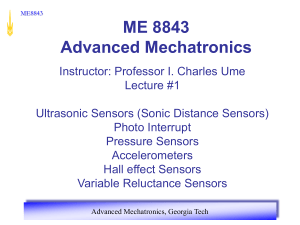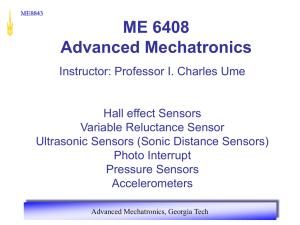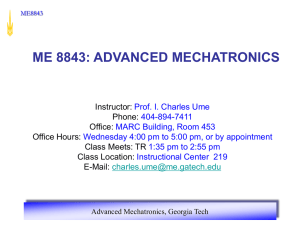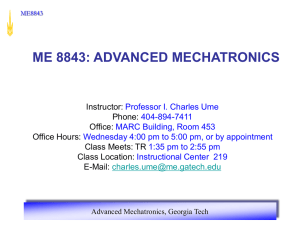Industrial Variable Reluctance Sensor
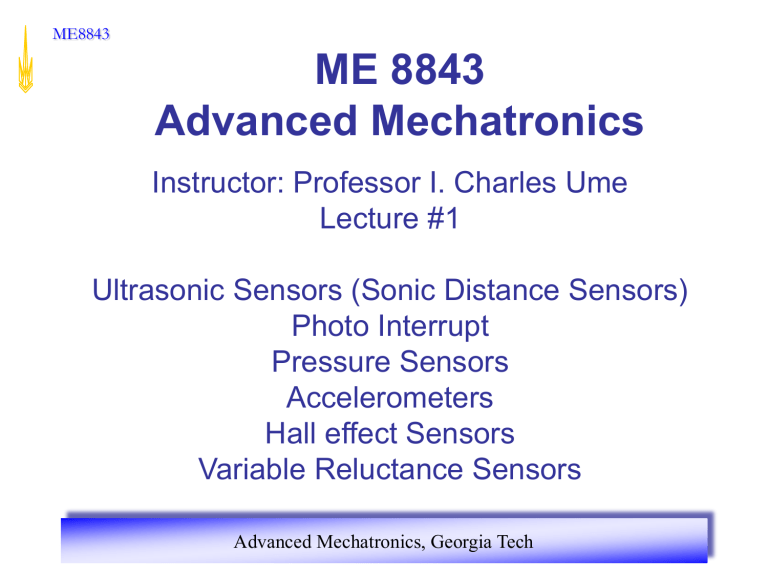
ME8843
ME 8843
Advanced Mechatronics
Instructor: Professor I. Charles Ume
Lecture #1
Ultrasonic Sensors (Sonic Distance Sensors)
Photo Interrupt
Pressure Sensors
Accelerometers
Hall effect Sensors
Variable Reluctance Sensors
Advanced Mechatronics, Georgia Tech
ME8843
• Ultrasonic transducer (piezoelectric transducer) is device that converts electrical energy into ultrasound
• Upon receiving sound echo (pressure wave) back from surface, ultrasound transducer will turn sound waves into electrical energy which can be measured and displayed
• Ultrasound are sound waves above normal range of human hearing (greater than 20K hertz).
Advanced Mechatronics, Georgia Tech
ME8843
Since piezoelectric crystal generates voltage when force is applied to it, same crystal can be used as an ultrasonic detector
Some systems use separate transmitter and receiver components while others combine both in single piezoelectric transceiver
Alternative methods for creating and detecting ultrasound include magnetostriction and capacitive actuation .
Pulse echo sensor
Transmit-Receive sensor
Advanced Mechatronics, Georgia Tech
ME8843
• Sound is transmitted through propagation of pressure in air
• Speed of sound in air is normally 331 m/sec at
0 o C and 343 m/sec at 20 o C for dry air
• Digital signal processor embedded in sensor calculates distance between sensor and object
Advanced Mechatronics, Georgia Tech
ME8843
x = v sound
. t
Where V sound is known, t = 0.5 (time of flight), x is distance between sensor head and object
Range of sensor varies between 5 cm to 20 m
Sensor is not appropriate for very short distance measurements
Frequency response (distance measurement update rate) varies with distance measured
– In general, it is about 100 Hz
Advanced Mechatronics, Georgia Tech
ME8843
• Piezoelectric crystals have property of changing size when voltage is applied
• Applying alternating current ( AC ) across them causes them to oscillate at very high frequencies, thus producing very high frequency sound waves.
• Ultrasonic sensors work on principle similar to radar or sonar
–Evaluate attributes of target by interpreting echoes from radio or sound waves respectively
Advanced Mechatronics, Georgia Tech
ME8843
Ultrasonic sensors generate high frequency sound waves and evaluate echo which is received back by the sensor
Sensors calculate time interval between sending signal and receiving echo to determine distance to object.
Advanced Mechatronics, Georgia Tech
ME8843
Applications
Medical:
Medical ultrasonic transducers (probes) come in variety of different shapes and sizes for use in making pictures of different parts of body.
Transducer may be passed over surface of body or inserted into body opening such as rectum or woman’s reproductive organ
Clinicians who perform ultrasound-guided procedures often use a probe positioning system to hold the ultrasonic transducer.
Advanced Mechatronics, Georgia Tech
ME8843
Technology can be used for measuring:
– Often used in robots for obstacle avoidance
– Wind speed and direction (anemometer),
– Fullness of tank, and speed through air or water
– Measuring amount of liquid in tank, sensor measures distance to surface of fluid.
– Other applications include: burglar alarms, non-destructive testing, and etc
Advanced Mechatronics, Georgia Tech
ME8843
Photo Interrupt
• Uses emitter and detector photo diode pair
• With no obstruction detector is high
• When an object blocks the light the detector is low
• Advantages
– Simple to interface
– Inexpensive
– Reliable
Advanced Mechatronics, Georgia Tech
ME8843
Photo Interrupt
Types
• Wide variety of packages and orientations
• Types
– Logic (digital ± 5 volts)
– Transistor/diode (analog)
• Manufacturers
– Fairchild
– Honeywell
Advanced Mechatronics, Georgia Tech
ME8843
Photo Interrupt
Applications
• Encoder wheel for angular measurements.
– Computer mouse with a ball
Advanced Mechatronics, Georgia Tech
ME8843
Photo Interrupt
Applications
• Detect holes or slots for positioning of liner slides
– Elevators
• Detect the location of products on and assembly line
Advanced Mechatronics, Georgia Tech
ME8843
Pressure Sensors
• Used to detect pressure of fluids or gasses.
• Technologies (many)
– Strain gage
– Piezoresistive
– Microelectromechanical systems (MEMS)
• Each sensor has a pressure range that it works in.
• Most have analog outputs that need amplification
– Some have built-in amplifiers for direct connection into microcontroller
Advanced Mechatronics, Georgia Tech
ME8843
Pressure Sensors
Types
• Differential Pressure
– Difference between two or more pressures introduced as inputs to the sensing unit
– 2 input
• Absolute/Gage Pressure
– The pressure relative to perfect vacuum pressure or set pressure (like pressure at sea level)
– 1 input
Advanced Mechatronics, Georgia Tech
ME8843
Pressure Sensors
Applications
• Measure pressure of gas or fluids
• Measure altitude
– For plains or weather balloons
• Measure flow
– pressure sensors in conjunction with the venturi effect to measure flow
• Measure depth of water
– When measuring liquids, most sensors are not rated to have unclean liquids contact the sensor components. A small amount of air in the tube right before the sensor will create a barrier from the liquid.
Advanced Mechatronics, Georgia Tech
ME8843
Accelerometers
• Used to measure acceleration
– Common SI units meters/second2 (m/s2) or popularly in terms of g-force (1 g is earth’s gravity)
• At rest an acceleration will measure 1 g in the vertical direction
• They can come in 1, 2 or 3 axis configurations
– With 3 axis it gives a vector of the accelerations direction (after
ME8843
Accelerometers
• Because of earth’s gravity, the sensor will read 1 to 0 g as the sensor is rotated from being vertical to horizontal.
– This can be used to measure angle the of tilt
• Each sensor has a range that it works in.
• Most have analog outputs that need amplification
– Some have built-in amplifiers for direct connection into microcontroller
Advanced Mechatronics, Georgia Tech
ME8843
Accelerometers
How they work
• Mechanically the accelerometer behaves as a mass-damper-spring system
– Many use Microelectromechanical systems (MEMS). Which use very small cantilever beams with masses on them
• Under the influence of gravity or acceleration, the proof mass deflects from its neutral position.
• This deflection is measured in an analog or digital manner
– Commonly the capacitance between a set of fixed beams and a set of beams attached to the proof mass is measured.
– Integrating piezoresistors in the springs to detect spring deformation is another method
Advanced Mechatronics, Georgia Tech
ME8843
Accelerometers
Applications
• Can be used to sense orientation, vibration and shocks.
• Used in electronics like the Wii and iPhone for user input.
• Acceleration integrated once gives velocity, integrated a second time gives position.
– The integration process is not precise and introduces error into the velocity and position.
Advanced Mechatronics, Georgia Tech
ME8843
Hall Effect Sensors
• Used to provide a noncontact means to detect and measure a magnetic field
• Named based on their use of the
Hall Effect, discovered by
Edwin Hall in 1879
Hall Effect Sensor Sensing a Shaft Speed http://farm1.static.flickr.com/62/227729006_fab88c1668.jpg?v=
0
Advanced Mechatronics, Georgia Tech
ME8843
How they work
• Presence of magnetic field deflects electrons flowing through a conductive material
Depiction of the Hall Effect
• As electrons move to one end of a conductive material, a potential is developed in the direction perpendicular to gross current flow
• This potential indicates the strength of the magnetic field http://upload.wikimedia.org/wikipedia/commons/a/ab/Ha ll_effect_A.png
Advanced Mechatronics, Georgia Tech
ME8843
Applications
• IC Engine Electronic Ignition Systems
– Used to determine position of cam shaft
• Brushless DC Motor Control
– Sensors determine position of permanent magnet rotor
• Assembly Lines
– Shaft position and velocity sensors
– Contactless limit switches
• Current Sensing ICs
– Electrically isolated alternative to shunt resistors
Advanced Mechatronics, Georgia Tech
ME8843
Hall Effect Sensor Types
• Linear Hall Effect Sensors
– Output is proportional to magnetic field strength
• Hall Effect Digital Switches
– Presence of field above threshold turns switch on
– Presence of field below threshold turns switch off
• Hall Effect Digital Latches
– North field turns latch on
ME8843
Packaging and Manufacturers
• ICs
– Analog Devices:
• AD22151G from Analog Devices
– Allegro MicroSystems, Inc.
• Wide range of linear, latching and switching sensors
• Great sampling policy
– Many, many more
SOT23
SIP http://www.allegromicro.com/en/Products/P art_Numbers/1120/pinout.gif
• Packaged units
– Honeywell
– Many, many more
Hall Effect
Sensor Module http://sensing.honeywell.com/client_asset/do cument/1/5/4/0/3/5/document_C3697B35-
Advanced Mechatronics, Georgia Tech C930-CB7C-FE090DFFCE61FB22.jpg
ME8843
Implementation and Words of
Warning
• Sensors may be affected by temperature variation. Some sensors incorporate circuitry to reduce this error.
• Sensors may be directional, in which case care must be taken with respect to orientations of sensor and magnet
• Some Hall Effect sensors detect presence of ferromagnetic materials, not magnetic fields
Advanced Mechatronics, Georgia Tech
ME8843
Variable Reluctance Sensors
• Used to measure speed and/or position of a moving metallic object
• Sense the change of magnetic reluctance
(analogous to electrical resistance) near the sensing element
Industrial Variable
Reluctance Sensor http://www.motionsensors.com/railwithoring
2.jpg
• Require conditioning circuitry to yield a useful signal (e.g.
LM1815 from National Semi.)
Advanced Mechatronics, Georgia Tech
ME8843
How Variable Reluctance
Sensors Work
• A magnet in the sensor creates a magnetic field
• As a ferrous object moves by the sensor, the resulting change in the magnetic flux induces an emf in the pickup coil
Variable Reluctance Sensor
Construction
Typical Configuration http://www.instronics.com/images/sensoronix/image.ds.drawing.v
Advanced Mechatronics, Georgia Tech r.jpg
ME8843
Typical Application
• Shaft velocity sensor for ABS/traction control
• Crank and cam shaft position sensors
Installed on CV axle
Sensor Schematic http://www.me.gatech.edu/mechatronics_lab/Projects/Spring07/Group1/dorthy
6.JPG
Advanced Mechatronics, Georgia Tech
ME8843
Interfacing Concerns
The emf is proportional to the rate of change of the magnetic flux. This dictates the ferrous material must be moving for the sensor to generate a signal.
Output voltage dependent on velocity of toothed wheel - performance may be reduced at slow speeds
Advanced Mechatronics, Georgia Tech


